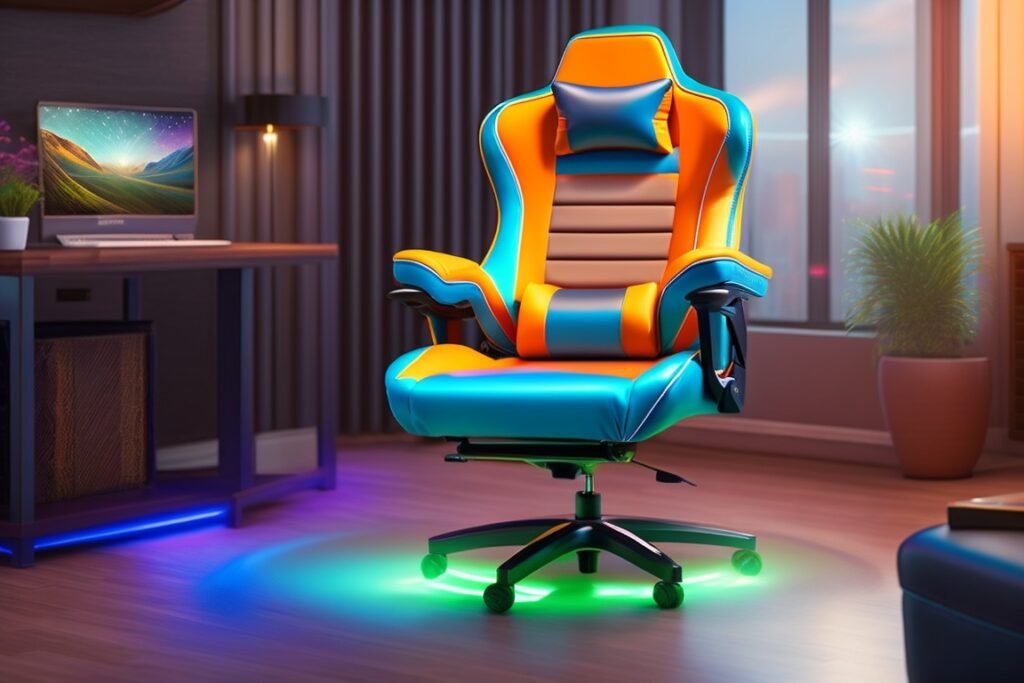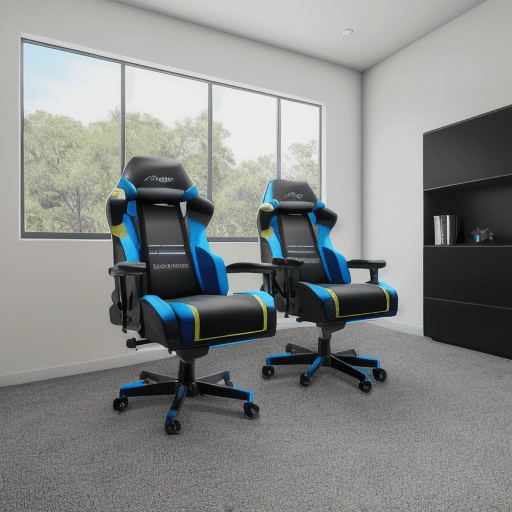Ergonomic design features play an integral role in providing optimal comfort for individuals. When ergonomics is incorporated into a space, it can result in improved posture and less fatigue from prolonged sitting or standing.

This article will explore the different design elements that contribute to enhanced user comfort through optimizing human interactions with furniture, tools, and technology.
Ergonomists have long advocated for ergonomic designs that are tailored to accommodate individual needs. By considering factors such as body size, task requirements, and existing office equipment, designers can create solutions that optimize movement efficiency while reducing musculoskeletal stress.
Through incorporating these principles of ergonomics into a workspace’s layout, users can experience greater levels of comfort and productivity throughout their day-to-day activities.
Adjustable Desks
Adjustable desks are an essential component of ergonomic design. By giving users the ability to adjust their desk height and angle, adjustable desks provide a level of customization that is not possible with fixed-height desks. This allows for improved comfort and posture while also reducing fatigue due to strain on the body.
Additionally, adjustable desks can help improve physical health by encouraging better sitting habits and posture during long work sessions. When selecting an ergonomic desk there are several things to consider such as size, shape, materials used in construction along with any additional features or accessories that may be included.
The ideal adjustable desk should be stable enough to withstand regular movement throughout the day without wobbling or shaking when typing or using your mouse. It should also have enough space for all necessary office items while providing easy access to everything needed during typical usage scenarios. Additional features like built-in cable management systems and monitor arms can make it easier to keep cords organized and out of sight while allowing more flexibility in how you arrange your workspace.
The proper use of ergonomics basics such as adjustable desks can go a long way toward promoting good physical health while enhancing productivity through increased comfort levels at the workplace. Adjusting a desk’s height and angle so that it meets individual user needs is just one step towards creating an efficient environment where workers feel comfortable doing their best work each day.
With this in mind, selecting an ergonomic chair becomes paramount in completing the comprehensive setup process for optimal comfort and wellbeing when working from home or within an office setting.
Ergonomic Chairs
The importance of ergonomic comfort cannot be overstated. While some may question the necessity of ergonomics, research has shown that it can play a major role in reducing fatigue and discomfort when working for extended periods at a desk or workstation.
Ergonomic chairs are one way to ensure optimal support is provided for the user’s body while seated. An ergonomic chair should have adjustable features so as to suit individual body shapes and sizes; these include height adjustment, seat depth adjustment, armrests that can move freely up and down, and lumbar support with an adjustable cushion.
Additionally, materials used should provide good postural awareness – look out for breathable fabrics such as mesh which will help keep you cool during long days spent sitting at your desk. When considering whether to invest in an ergonomic chair for home use or office use, it is important to understand the range of features available on different models as well as the cost implications attached to each option.
Evaluating your needs carefully before making a purchase will make sure you get the most suitable product for your requirements. With this knowledge in hand, let’s take a closer look into keyboard trays- what they are, why they might be beneficial and what types are available on the market today.
Keyboard Trays
When it comes to ergonomically designed workspace furniture, keyboard trays are a great addition. Keyboard trays provide an easy way for users to adjust the height of their keyboards and mice while also allowing them to store items such as paper clips and sticky notes beneath the desk in an organized fashion.
This allows for better ergonomic positioning of the arms, neck, and wrists by keeping your elbows at a 90-degree angle instead of having to hunch over or reach up when typing.
The type of keyboard tray used should be based on user preference. Some trays can slide out from underneath the desk and sit flat on top of it so that they can be adjusted easily, while others attach directly onto the underside of the desk with adjustable heights for optimal comfort.
The latter option is ideal for those who don’t want any additional under desk storage space taken away from their workstation area.
Keyboard trays come in various sizes and styles, including ones that have wrist rests built into them for added support during use. They also help alleviate strain on the back muscles caused by improper posture, making long hours spent working more comfortable than ever before.
With these features combined together, users can enjoy improved productivity thanks to increased comfort levels throughout extended periods of computer usage.
Monitor Arms
Mapping out monitor setups, ergonomists prioritize proper positioning.
Positioning the monitors at an optimal height and distance from the user is essential for comfort and productivity in the work environment.
By adjusting a monitor arm to support the display’s weight, workers can adjust their screen to match their sitting position without putting strain on their neck or eyes.
Monitor arms provide adjustable flexibility that allows users to personalize their workstation set-up based on individual preference.
Adjustable tilt tension and gas spring counterbalancing allow for easy repositioning of the displays while maintaining stability throughout its range of motion.
With performance features such as cable management systems built into many of these arms, users are able to keep cords neat and organized while they move around their workspace with ease.
Ergonomic positioning helps reduce fatigue, visual stress, and physical discomfort associated with computer use by allowing users to maintain comfortable postures when using multiple screens across different areas in a given space.
This makes monitor arms an invaluable tool for creating efficient workspaces tailored to each person’s unique needs.
Foot Rests
Foot rests are an important component of the ergonomic design as they provide support and comfort for a person’s feet when seated. Proper height is essential to ensure that there is no strain on joints or muscles.
To achieve this, footrests should be adjustable to accommodate different leg lengths and seating postures. Padded cushions can also help to reduce pressure points underfoot.
The angle of the foot rest relative to the floor should also be taken into consideration in order to maximize user comfort. The ideal angle would allow for the knees and hips to form a 90-degree angle while sitting, with the feet flat against the surface of the foot rest. This helps avoid any unnecessary stress on lower back muscles which can contribute to fatigue over time.
Ergonomically designed foot rests offer users additional stability as well as improving overall posture and circulation when seated for long periods at a desk or workstation. When correctly adjusted, it will enable you to maintain healthy posture without having to constantly adjust your position throughout the day.
In addition, incorporating a padded cushion provides extra cushioning for added comfort and reduces risk of injury due to overexertion from prolonged use of hard surfaces such as wood or metal materials. With these features in mind, task lighting may become necessary depending on individual preferences for optimal productivity levels.
Task Lighting
Task Lighting is an important ergonomic design feature for optimal comfort in the workplace.
Adjustable Lighting allows users to customize the intensity and position of the light, which helps to minimize glare and eye strain.
Additionally, using energy efficient lighting helps to reduce energy costs while still providing adequate lighting for tasks.
Finally, task lighting should be properly balanced with other elements to create a comfortable and productive work environment.
Adjustable Lighting
The importance of adjustable lighting in ergonomic task design cannot be overstated. Accurately adjusted lighting can improve visual comfort and reduce eye strain, with the end goal being to create a work environment that is both productive and pleasant for employees.
Adjustable Lighting Temperature stands as one of the most important aspects of creating an optimal lighting setting for any workspace or home office. By providing adequate illumination at comfortable light temperatures, users can maximize their productivity while avoiding issues such as glare and eyestrain from prolonged exposure to bright lights.
Lighting Position is another crucial element when configuring ergonomic task lighting for maximum efficiency. Light sources should never be positioned directly above monitors or user’s heads, as this can cause glare on screens and physical discomfort due to overexposure to direct light beams. Instead, it is best practice to position lamps at least 24 inches away from monitors so that light sources are not shining into users’ eyes or causing reflections on displays.
It may also be beneficial to incorporate multiple smaller lamp fixtures distributed around the desk instead of relying on single overhead lamps which could become uncomfortable after extended periods of use.
Adjustable Lighting features allow users to customize their workspace based on individual needs and preferences while still adhering to ergonomics guidelines essential for maintaining proper posture during tasks requiring prolonged sitting or standing positions. When properly implemented, these features can help workers maintain healthy habits by reducing eye fatigue, improving focus, increasing accuracy, and ultimately promoting higher levels of productivity throughout the day.

Energy Efficiency
As an ergonomics consultant, it is essential to consider the energy efficiency of task lighting when designing workspaces for optimal productivity and comfort.
While adjustable lighting temperature and position are key components in achieving effective illumination while minimizing eyestrain, there are additional considerations in creating a workspace that meets both ergonomic guidelines and increases overall operational cost savings.
To ensure that offices have efficient systems in place, conducting regular energy audits can be beneficial as they provide valuable insights into how much electricity the organization is using on a daily basis and identify where improvements could be made.
Additionally, addressing air quality by investing in high-grade HVAC equipment or natural ventilation solutions can help reduce electric costs while maintaining healthy indoor environment conditions for workers.
By following these steps, businesses will not only benefit from reduced operating expenses but also create work environments that promote employee wellbeing through improved posture, focus, accuracy, and productivity.
Mousepads
Achieving comfort in your workspace can be a challenge, but with the right mousepads you won’t even have to break a sweat. Mousepads are essential ergonomic accessories that make navigating your computer’s cursor easier and more comfortable for long periods of time.
Ergonomic shapes, wireless designs, and materials that provide excellent tracking accuracy are all features to look for when choosing the perfect mousepad. For those who prefer wireless mice, there is an array of options available on the market today including ones specifically designed for gaming or everyday use.
With various sizes, colors, and textures to choose from, it’s easy to find one that fits your style perfectly while offering superior functionality. Some may even come with wrist rests which helps alleviate pressure on your wrists during extended sessions at the desk.
The bottom line is this: if you want ultimate comfort as well as improved performance in your task-oriented activities like workstation navigation, then investing in a good quality mousepad should be top priority. It’s no exaggeration – having the right kind of mouse pad makes all the difference! Moving forward we’ll explore other ergonomic accessories that can help create a more optimized workspace experience.
Other Ergonomic Accessories
Ergonomic accessories are an important part of achieving optimal comfort in any workspace.
Ergonomic keyboards are designed to support the natural position of your hands, wrists and arms while typing for extended periods of time, as well as reduce strain on muscles and joints.
Wrist rests can also help by providing extra cushioning that relieves pressure from repetitive motions.
Another ergonomic accessory is a footrest which helps maintain proper posture while seated.
It ensures feet remain flat on the ground with knees bent at a 90-degree angle or greater – helping to avoid back pain caused by poor positioning when sitting for long periods of time.
Footrests come in adjustable height models so they can be tailored to individual needs.
Lastly, anti-fatigue mats provide relief from uncomfortable standing surfaces such as concrete floors.
They absorb shock and offer extra cushioning for legs, ankles and feet – helping to alleviate discomfort during prolonged standing tasks.
Anti-fatigue mats are available in various sizes based on the space available and type of work environment.
Frequently Asked Questions
What Is The Average Cost Of Ergonomic Furniture?
When considering the purchase of ergonomic chairs, budget should be a primary concern.
The average cost of an adjustable chair with ergonomic design features will vary greatly depending on its quality and size.
However, a basic entry-level model can range from $200 to $400 or more for higher-end models that offer additional adjustability in terms of seat height and lumbar support.
Ultimately, it is important to ensure you are making an investment that will provide comfortable support and long term durability.
How Often Should Ergonomic Furniture Be Replaced?
The ergonomics industry has seen a dramatic growth in recent years, with studies showing the average lifespan of ergonomic furniture ranging from five to seven years.
This is largely due to advances in technology that allow for the redesigning of spaces and improved human posture.
However, it is important to note that many factors can influence this, such as usage frequency, environmental conditions and cleaning techniques.
As such, an experienced ergonomics consultant should be consulted at least once every two to three years in order to ensure optimal comfort levels are maintained for users of ergonomic furniture.
What Are The Benefits Of Ergonomic Furniture?
Ergonomic furniture has been proven to provide a range of benefits, such as improved posture and reduced stress.
This is due to the design features that focus on providing optimal comfort; these include adjustable seat heights, armrests, backrests, and lumbar support.
Such ergonomically designed products can help individuals maintain good posture while sitting for long periods of time and reduce their risk of musculoskeletal issues caused by poor posture or awkward movements.
Furthermore, ergonomic furniture helps minimize fatigue and discomfort by allowing users to adjust it according to their individual needs.
As such, it provides an ideal solution for those seeking increased productivity and performance in their work environment without sacrificing comfort.
Are There Any Safety Considerations To Be Aware Of When Using Ergonomic Furniture?
When considering ergonomic furniture for use in the workplace, it is important to remember that safety should always be a top priority.
Proper posture and adjustable settings are key elements when using such furniture, as they can help reduce strain on the neck, back, wrists, shoulders and legs which may lead to long-term health issues if not addressed properly.
With modern design features allowing for optimal comfort, users of this type of furniture must ensure they have adjusted their chair or workstation correctly so that any potential risks associated with incorrect usage are mitigated.
By doing so, one can enjoy the many benefits that ergonomic furniture has to offer without compromising safety.
Is There Any Evidence That Ergonomic Furniture Actually Improves Comfort?
Recent research has suggested that ergonomic furniture is an effective way to improve comfort levels.
Ergonomically designed furniture allows for better posture, which can reduce strain on muscles and joints.
Additionally, the ability to make adjustments such as seat height and armrests ensures a better fit for the user’s body type.
This results in enhanced comfort during extended periods of sitting or standing.
The combination of these factors provides evidence that ergonomic furniture actually does improve comfort levels when compared with traditional options.

Conclusion
Ergonomic furniture can be a worthwhile investment for those looking to improve their comfort and productivity.
While there is an initial cost associated with ergonomic furnishings, the long-term benefits of increased body support and reduced fatigue are well worth it.
With proper maintenance, quality pieces should last for many years.
Safety considerations must also be taken into account when selecting this type of furniture; however, research has shown that ergonomically designed features provide superior comfort over traditional designs.
In essence, investing in ergonomic design is like planting a seed: its effects may not be immediately apparent but will only grow with time as we reap the rewards of improved health and wellbeing.

Sha Neumeister, the visionary behind SomosVisibl.com, is a connoisseur of gaming chairs that prioritize both style and comfort. With an unparalleled understanding of ergonomics and a passion for enhancing the gaming experience, Sha curates a collection of gaming chairs that offer impeccable support and aesthetic appeal. Elevate your gaming setup with Sha’s handpicked selection of gaming chairs, designed to keep you comfortable and immersed in your virtual adventures.








